Setup Product
The Setup Product page is divided in two areas:
-
A service options and services area; a high level overview of the service options and services that are included in the product
-
A product service definitions area; used to configure the service definitions contained in the product
In addition multiple dialogs are available for configuration of the product and its contents, accessed through the "Product" drop-down button displayed at the top. The possible options contained in the "Product" drop-down button are dependent on whether a product is in focus or not. Accessing the page from the "Create a Product" menu link will open the page without a product in focus, allowing the creation of a new product (or a product copy). Accessing the page from the view products page or after creation of a product, the "Product" drop-down button will contain options for configuration of the product in focus.
There are several workflow related buttons ("Edit", "Review", "Test" and "Approve") which set the status of the product. The "Review" button also triggers a build mechanism that converts the service definitions and product service definitions into benefit specifications and product benefit specifications, creating a product with a structure that can be exported to a claims engine. When a product has status Edit also a "Validate" button is displayed that triggers a product validation.
The "Messages" button accesses a dialog to view all message s resulting from product validation. The "Processing Errors" button functions as a link to the technical errors page.
This document will cover the step-by-step configuration of a new product and the creation of a product based on a copy.
The page is accessed though the Products menu, under the sub-menu item Products, with the link "Create a Product" or with the link "Overview" and then selecting the "Setup Page" link for a specific product.
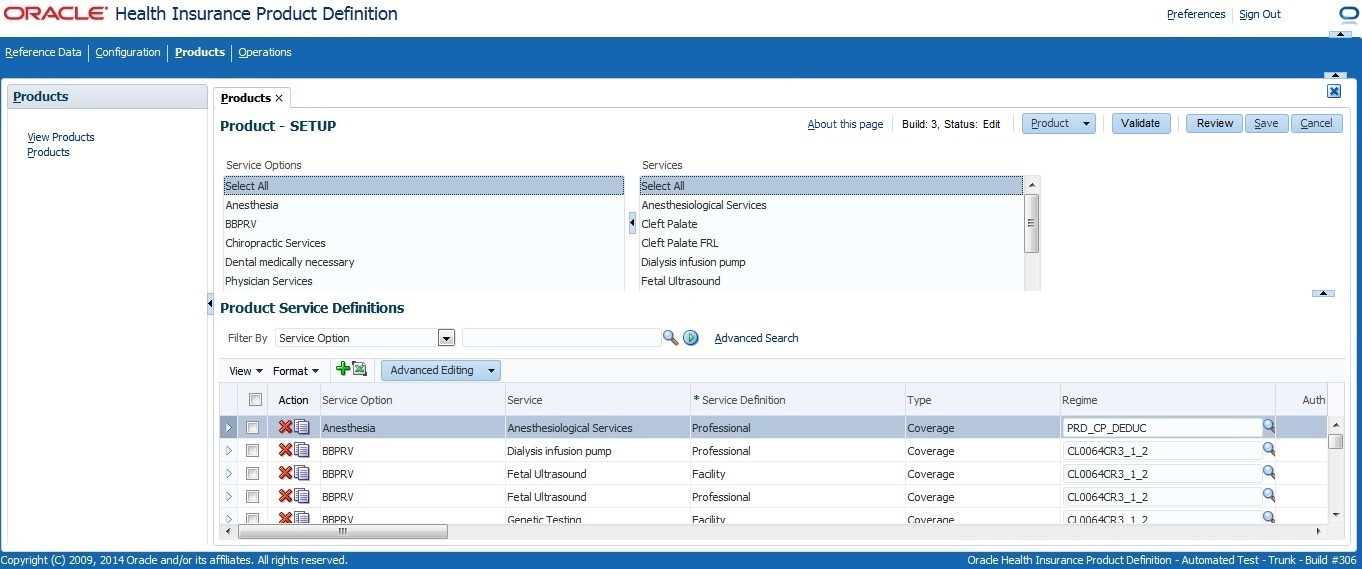
Creating a New Product
When configuring a product that is not based on a copy of another product, configuration starts off by navigating to the page using the "Create a Product" menu link and selecting the "New Product" option from the "Product" drop-down button. This will display a detail dialog used to configure the attributes of the product. The following fields can be entered:
-
Code (mandatory)
-
Description (mandatory)
-
Aggregation Level (mandatory)
-
Default Start Date (mandatory). Sets the start date for product service definitions that are added to this value, speeding up configuration. Determines the start date of product limits.
-
Brand (mandatory)
-
Product Line
-
Product Family
-
Funding Arrangement
-
Currency (mandatory)
-
Priority * Template Product? Template products can be used as the source for product copies.
-
Source Product; selecting a source product will also set the source template field.
-
Source Template; updating the source template field will clear the source product field.

After entering values and clicking "OK" the focus returns to the main page and the next configuration steps can be executed. These consist of the following:
-
Defining the product network
-
Defining the renewal periods of the limits used in the product
These two activities can be done anytime during the product configuration process, there are no dependencies with other activities. In addition three other activities can be executed:
-
Adding service options and services to the product
-
Adding service definitions to the product
-
Defining parameter values for the cover withhold categories and limits configured for the included service definitions
These three activities need to be undertaken in the specified order. Services need to exist for a product before it is possible to add service definitions. The list of possible parameters to assign a value to is dependent on the configuration of the included service definitions.
Product Properties
The "Properties" option from the "Product" drop-down button accesses the same detail dialog that appears when a new product is created (see above). This is to allow updates to the properties of the product.
Provider Groups
The "Provider Groups" option from the "Product" drop-down button accesses a detail dialog used to include provider groups into the product, creating the product network.
The following fields can be entered:
-
Provider Group (optional)
-
Assignment Label (optional)
-
Start Date (mandatory)
-
End Date
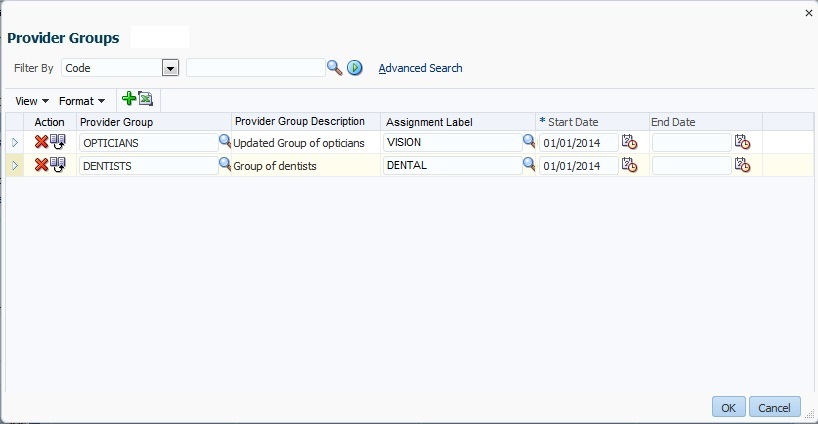
Renewal
The "Renewal" option from the "Product" drop-down button contains a sub-menu with three options:
-
Open
-
Set to Calendar Year
-
Set to Plan Year
-
Set to Annual
The option "Open" accesses a detail dialog used to configure to which limits a product counts and what renewal period and (other products) carry over period needs to apply for each limit within the context of the product.
The following fields can be entered:
-
Limit (mandatory)
-
Reference (mandatory)
-
Renewal Period (length and UoM, mandatory)
-
Carry Over Period (length and UoM)
-
Other Prod. Carry Over Period (length and UoM)
-
Annual Limit Start Month
-
Start Date (mandatory)
-
End Date
Renewal period (length and unit of measure) and Reference together indicate the renewal period. For example; a limit renews every calendar year or every two years from product enrollment or annually. The (Other Prod.) Carry Over Period (length and unit of measure) indicates the carry over that needs to be applied to the limit. For example; when a period of one calendar year is defined with a carry over of three months this means that amounts counting towards that limit encountered on claim lines in the last three months of 2013 are also counted towards 2014.

The renewal period of a limit is defined on product level, on the product service definition level it is defined to which limits a product service definition counts, using the renewal defined on product level.
-
The option "Set to Calendar Year" will update all the product limit renewal periods with the reference "Plan Year" or "Annual" to the reference "Calendar Year".
-
If multiple exist for the same Limit, only the most recent one (based on start date) will be updated
-
The option "Set to Plan Year" will update all the product limit renewal periods with the reference "Calendar Year" or "Annual" to the reference "Plan Year".
-
If multiple exist for the same Limit, only the most recent one (based on start date) will be updated
-
The option "Set to Annual" will update all the product limit renewal periods with the reference "Calendar Year" or "Plan Year" to the reference "Annual".
-
If multiple exist for the same Limit, only the most recent one (based on start date) will be updated
-
A typical product has somewhere between 30 and 50 limits that are either calendar year or plan year or annual based. Within the product it’s always one or the other (a combination of both in the same time period will result in a validation error). Being able to update these limits in bulk speeds up product configuration.
Included Services
The "Included Services" option from the "Product" drop-down button accesses a detail dialog used to add and remove service options and services to and from the product.
The dialog displays the service options and services that are configured and displays the following fields:
-
In Product? Indication if the item is included in the product.
-
Product Service Definition Count. The number or underlying product service definitions (only for services).
-
Short Code
-
Code
-
Description
-
Active? Indication if the item is active and can be included (only for services).
Adding and removing service options and services is done by checking the check-box of the service or service option record in combination with the "Add Selected" and "Remove Selected" buttons.
-
Adding a service option also includes all underlying services that are active and included by default (settings when configuring the service) in the product.
-
Removing a service option from a product will remove all underlying services from the product.
-
Adding a service to the product will not add any underlying service definitions, this is done with the "+" icon or with the advanced editing feature "Add Service Definitions to Product".
-
Removing a service from the product will not remove any underlying service definitions that have been added to the product (records visible in the product service definitions table that is discussed Setup Product). This needs to be done by the user.
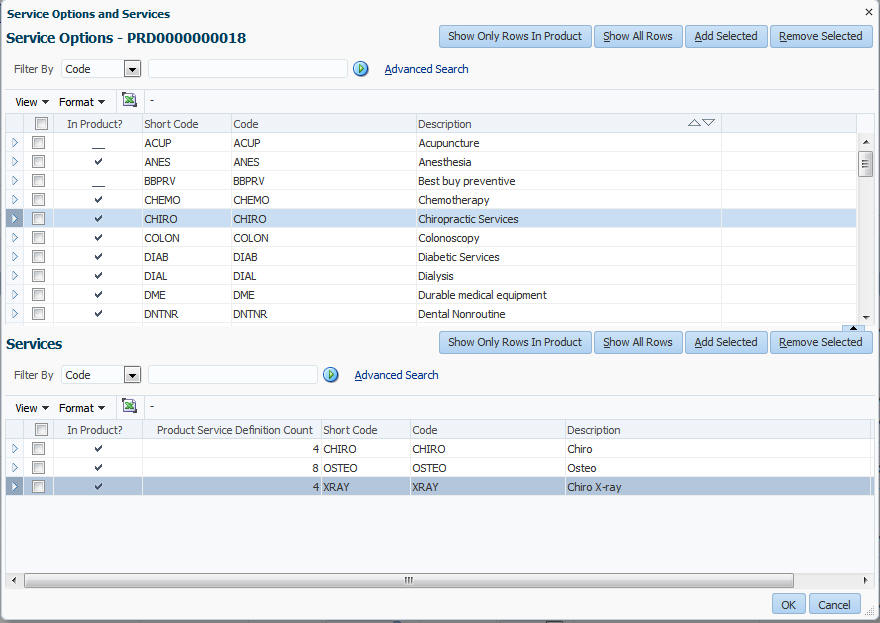
After adding service options and services they appear in the "service options and services" area of the main page, displaying all the included service options and services. The part displaying the included services acts as a filter for the service definitions that are included in the product. Selecting a service in that area will limit the displayed service definitions to those that are a child of the selected service. Selecting a service will also limit the service definitions that can be added with the "+" icon or are added with the advanced editing feature "Add Service Definitions to Product".
It is possible to view all the included service definitions by selecting both "Select All" options in the "service options and services" area.
Service Definitions
After configuring the included service options and services, the next step is to add service definitions to the product. These indicate which medical service will be covered (the service definition) and under what conditions (the product service definition).
An advanced editing function is provided to quickly add all the underlying service definitions that are active and included by default for a single included service or for all included services, dependent on the selected service in the service options and services area of the page. This button is located under the "Advanced Editing" drop-down button and is labelled "Add Service Definitions to Product".
Note that product service definitions do not have any uniqueness constraints or mandatory fields (except for the service definition and start date) during configuration. This is validated upon building the product.
The following fields can be entered:
-
Service Definition (mandatory)
-
Regime
-
Auth. (Authorization) Missing? If the service definition is of type coverage this indicator is mandatory (unchecked by default)
-
Network Status. Are the product provider groups in or out of scope (or either)
-
Specific Networks. This field consists of two parts: a read-only list of provider groups (including assignment labels) that are connected specifically to the product service definition and the scope (updatable) of these groups (are they in of out of scope for the product service definition). The provider groups (including assignment labels) can be added in a separate dialog by clicking on the Add icon. Once added, the same dialog can be opened again (if updates are required) by clicking on the read-only list (link). Adding specific networks to multiple product service definitions at once can be done with the advanced editing option "Add Specific Networks". Removing all specific networks from multiple product service definitions at once can be done with the advanced editing option "Remove Specific Networks". Updating the scope on multiple product service definitions at once can be done with the advanced editing option "Update Selected Rows". The different advanced editing options are described in the sections below.
-
Multiple parameter columns for the situations where it is possible to select a parameter alias for a cover withhold category or limit. Examples covering these situations are explained in Product Configuration Examples
-
When a limit has the indication "Display in UI" and the limit is selected as a adjudication limit for the product service definition
-
When a cover withhold category is indicated as such, by setting its type and a regime is selected containing the cover withhold category as a parameter
-
-
Adjudication Stop Limits. A list of the limits that apply to the product service definition with reached action "Stop". Configured with the advanced editing option "Accumulation Options"
-
Adjudication Continue Limits. A list of the limits that apply to the product service definition with reached action "Continue". Configured with the advanced editing option "Accumulation Options"
-
Gender
-
Age From
-
Age To
-
Empl. (Employer) Usage. Is the specified county region (or group) in or out of scope.
-
Employer Country Region
-
Employer Country Region Group
-
Pers. (Person) Usage. Is the specified county region (or group) in or out of scope.
-
Person Country Region
-
Person Country Region Group
-
Prov. (Provider) Usage. Is the specified county region (or group) in or out of scope.
-
Provider Country Region
-
Provider Country Region Group
-
Condition
-
Priority
-
Start Date (mandatory)
-
End Date
| The total number of parameter columns is variable. A common scenario would be one for copay, one for coinsurance and a few for tiered limits. Larger numbers of dynamic columns are possible. |
Any dynamic fields defined for the product service definition appear in the page.
Searching
The page allows a quick search on two dimensions instead of a single one, making it possible to quick search on one or two conditions. The second quick search field provides the same functionality as the first one.
The page also allows the user to use both the advanced and the quick search on several details of the product service definition. For example, the user can search on all product service definitions that contain a specific adjudication limit. The following details are included in the search functionality:
-
Specific Networks
-
Adjudication Limits
The specific networks field is displayed as a column containing two values in the product service definitions table. It contains a scope and a list of provider groups (including assignment labels). The search function allows the user to search on this combination (scope, provider group and assignment label) of values when searching for specific networks. To this end, the "Specific Networks" option provides drop-down box containing the "In / Not In" scope options, a provider group field and an assignment label field. For example, it is possible to search for all product service definitions containing the specific network "DENTAL_ADVANCED" being in scope.
Whenever a dynamic column is added to the product service definitions table, because the user is able to select a parameter alias for a cover withhold category or limit, the column is also added to the quick and advanced search. This allows searching on all the product service definitions that have selected a specific alias.
The page also allows the user to search for empty values (e.g. product service definitions without a regime). The following fields allow for searching on empty values:
-
Regime
-
Network Status
-
Specific Networks
-
Parameter columns (used to select the correct parameter alias for a cover withhold category or limit)
-
Adjudication Limits
-
Employer Country Region / Employer Country Region Group
-
Person Country Region / Person Country Region Group
-
Provider Country Region / Provider Country Region Group
-
End Date
Editing Features
The following buttons are displayed in the product service definitions table area or in the advanced editing function above the table area:
| Field | Remark | Example |
|---|---|---|
Check-box (first column) |
Used to select rows one by one or to (de)select all rows with the topmost check-box. Used in conjunction with the advanced editing features |
|
Update Selected Rows (advanced editing feature) |
Allows an update of a single field for multiple rows at once by selecting the field and then selecting a value. Single-value non-time-valid fields can also be updated with this feature. The regime and auth missing? fields can only be updated if the selected rows are of the same type of service definition (cover, auth, wait, reser or post) |

|
Copy Selected Rows (advanced editing feature) |
This feature allows for the copying of multiple rows at once. This is a "copy with children" function that also copies the product service definition provider groups, selected accumulation options and parameter alias usages associated with the copied product service definitions. No save action is executed after the copy action. The copied product service definitions will be identical, key fields need to be updated manually |
|
Delete Selected Rows (advanced editing feature) |
This feature allows for the deletion of multiple product service definitions at once. The same delete restrictions apply here as for deleting a single record. |
|
Add Service Definitions to Product (advanced editing feature) |
An advanced editing function is provided to quickly add all the underlying service definitions that are active and included by default for a single included service or for all included services, dependent on the selected service in the service options and services area of the page. |
|
Add Accumulation Options (advanced editing feature) |
Feature to define the limits to which a product service definition counts, see below. |
|
Add Specific Networks (advanced editing feature) |
Feature to add (through a detail dialog) specific networks (provider groups including assignment labels) to multiple product service definitions at once. Note that this feature does not remove existing specific networks from the selected product service definitions. |
|
Remove Specific Networks (advanced editing feature) |
Feature to remove all specific networks from multiple product service definitions at once. |
Adjudication limits are added though a detail dialog named "Add Accumulation Options" that is used to connect multiple limits to multiple product service definitions with a single action. An accumulation option is a combination of a cover withhold category, a limit and a reached action. For example: the cover withhold category "Deductible" counts towards the limit "In-Network Insurable Entity Deductible" and stops counting when the limit is reached.
The detail dialog displays all the accumulation options based on the selected cover withhold rule that is part of those accumulation options. A tri-state check-box indicates if none, some or all of the selected product service definitions include the accumulation option. Changing the check-box settings will include or remove accumulation options from the selected product service definitions. The possible options are:
-
Unchecked box; none of the selected product service definitions include the accumulation option
-
Box filled with a square; a part of the selected product service definitions include the accumulation option
-
Checked box; all of the selected product service definitions include the accumulation option
A box filled with a square can only be manipulated by the user if it is selected by the system upon opening the page. If in such a situation the user first checks or un-checks the box then he is allowed to undo this change by going back to its initial square state. If the check-box is checked or un-checked by the system upon opening the page, it is not possible to go to the box filled with a square state.

Cost Sharing
The "Cost Sharing" option from the "Product" drop-down button accesses a detail dialog used to define the parameter values for the limits and cover withhold categories that allow for parametrization.
The dialog displays the parameter aliases that are included in the product and displays the following fields:
-
Parameter
-
Parameter Value (Value and Type)
-
Start date
-
End date
Functionality is provided for so that you can switch between seeing all parameter values or just the most recent ones (in terms of time validity). Creating values for new time periods can be done by duplicating existing ones and changing the time validity. In addition, the '+ 1 year' button will create new time periods for all parameters that are not immutable (not only the ones that are visible in the dialog) at once with a new start date that is set to the start date of the existing record plus one year.
The shown parameters depend on the used coverage regimes and selected adjudication limits. The page displays the parameter aliases that where selected during the configuration of the product service definitions (if a limit only has a single parameter alias it is selected automatically). Values displayed in this detail dialog apply to all the product service definitions that have selected that parameter alias.
In is possible to define the parameter value at the level of the parameter alias (i.e. in the setup parameter alias page). This results in a parameter value that is immutable at the level of the individual product (it is view only in the dialog) and it applies to all products referencing that alias (this feature is used, for example, for state mandates). Note that when a parameter alias value is specified, it prevents entering a parameter value for a product wholesale, so for any time validity period.
It is possible to define dynamic fields for a product parameter. Whenever a product is built any dynamic field values defined at this level are copied to dynamic field (of the same name) on the product benefit specification value or product benefit specification limit that is created for that parameter.
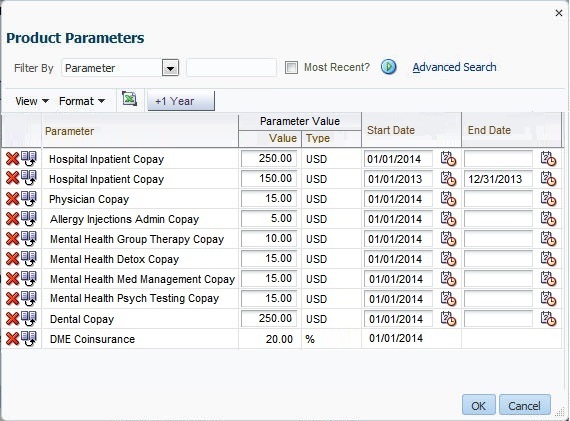
Product Status
A product can have one of the following statuses:
-
Edit
-
Queued
-
Review
-
Test
-
Approved
Edit
This is the initial status of a product. The user can make changes to the product and validate the product using the "Validate" button. After finishing the configuration of a product the user can set the status of the product to Review using the "Review" button (only displayed for products with status Edit). The "Review" button also triggers a build of the product.
Note that whenever a validate or build process is running for a product the setup product page is immutable for that product (view only), with a "Validation/Build in progress. The product cannot be edited now." message informing the user about the state of the page. After the process is done the page is refreshed, reactivating the page. These actions can only be executed for a product with no unsaved changes.

Validate
The "Validate" button triggers the process that will validate the product that is in focus, the executed validations are described.
Any resulting validation messages can be viewed through the messages dialog that is accessed with the "Messages" button. This button is only active if messages exist for the product.
If the validation process encounters a (technical) processing error, the resulting error message can be viewed through the technical errors page that is accessed with the "Processing Errors" button. This button is only active if the most recent product validation process resulted in a processing error.
Only executing the validation process can be used to check if the configured product complies to all the validations or if any corrections during configuration still need to be made.
The page title communicates the validation status of the product to the user. If a product is not validated, because it is new, no suffix is displayed. If a product is valid, the title is suffixed with "Validated". If a product is not valid, the title is suffixed with "Existing Messages", prompting the user to access the messages dialog. If a processing error was encountered during validation, the title is suffixed with "Existing Processing Error", prompting the user to view the technical errors page.
Whenever a validate or is running for a product the setup product page is immutable for that product (view only), with a "Validation/Build in progress. The product cannot be edited now." message informing the user about the state of the page. After the process is done the page is refreshed, reactivating the page.
Build
The "Review" button triggers the process that will build the product that is in focus, the process results in a product - benefit specification structure that can be imported into a claims engine and is described.
The build product process will always start with executing the validation process, if any validation errors are found the product will not be built. If the build is successful, the Build Number on the product is incremented by 1 (the Build Number is displayed at the top of the page next to the buttons).
Queued
The product has been submitted for a build (using the "Review" button). The user cannot make changes to the product or validate the product.

Review
The user can review the product. There is no dedicated product review page in the application. The reviewer uses the product page to look at the configured product. The user cannot make changes to the product or validate the product. The user can set the status of the product back to Edit using the "Edit" button or set the status to Test using the "Test" button. Note that the "Test" button is only visible for users that have an access restriction of type Submit Product to Test.

Test
The product is ready to be loaded into a OHI Claims Adjudication test environment. The user cannot make changes to the product or validate the product. The user can set the status of the product back to Edit using the "Edit" button or set the status to Approved using the "Approve" button. Note that the "Approve" button is only visible for users that have an access restriction of type Approve Product.

Creating a Product Copy
The "Copy Product" option from the "Product" drop-down button accesses a detail dialog used to create a copy from a product. This option is only available if the page is accessed through the "Create a Product" menu link.
The dialog displays the following fields:
-
Product (mandatory). Only products that are indicated as being a template product can be selected as a source product.
-
Code (mandatory)
-
Description (mandatory)
After selecting "OK", the following components are copied from the Product (and the new product is saved):
-
The product attributes, but not the template indicator (set to No), validation status (set to Not Validated), product status (set to Edit), build number (set to 0) and aggregation level (set to the entered Code value)
-
The source product and source template fields are set as follows:
-
Source Product. Empty if the "copied from" product is a template. Otherwise the "copied from" product
-
Source Template. If the "copied from" product is a template, then the "copied from" product. If the "copied from" product is not a template, then the same value as the source template field on the "copied from" product.
-
All active Product Provider Groups
-
All Product Limit Renewal Periods
-
All Product Service Options
-
All active Product Services
-
All active Product Service Definitions (and their details)
-
All Parameter Values
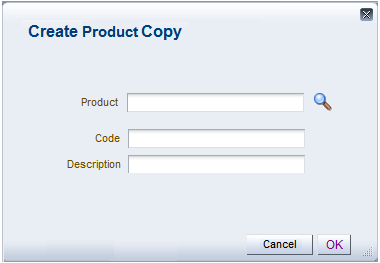
| It is not possible to create copies of products that are defined for an inactive brand, these products do not appear in the list of source products. If this is required, create the product copies prior to deactivating the brand. |
